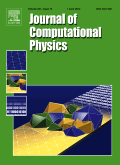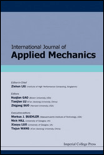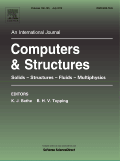
PROBABILISTIC ENGINEERING MECHANICS
Scope & Guideline
Unlocking Insights in Probabilistic Engineering Applications.
Introduction
Aims and Scopes
- Reliability Analysis and Assessment:
The journal emphasizes the development and application of probabilistic models for reliability analysis of engineering systems, including structures, materials, and mechanical components. This includes methodologies for estimating failure probabilities, performing sensitivity analyses, and conducting risk assessments. - Uncertainty Quantification:
Research published in the journal focuses on quantifying uncertainties in engineering applications through various statistical and probabilistic techniques. This encompasses modeling uncertainties in material properties, loading conditions, and structural responses. - Statistical Modeling and Data-Driven Approaches:
The journal encourages the use of statistical methodologies and data-driven approaches, such as machine learning and Bayesian methods, to improve predictions and analyses of engineering systems under uncertainty. - Stochastic Modeling of Dynamic Systems:
A significant area of focus is the stochastic modeling of dynamic systems, including the analysis of vibrations, impacts, and other time-dependent behaviors influenced by random processes. - Multiscale and Multidimensional Approaches:
The journal highlights the importance of multiscale and multidimensional methodologies in addressing complex engineering problems, particularly those involving heterogeneous materials and spatial variability. - Performance-based Engineering:
There is a consistent focus on performance-based approaches to engineering design and assessment, particularly in the context of seismic and environmental loading, which consider the probabilistic behavior of systems to meet safety and functionality criteria.
Trending and Emerging
- Machine Learning and AI Integration:
There is a growing trend towards integrating machine learning and artificial intelligence techniques into probabilistic modeling and uncertainty quantification. This trend reflects the need for more efficient and accurate predictive models in engineering applications. - Bayesian Updating and Inference:
Bayesian methods are increasingly being utilized for model updating and parameter estimation, reflecting a trend towards more sophisticated statistical approaches that can incorporate prior knowledge and adapt to new data. - Multiscale Modeling:
An emerging focus on multiscale modeling techniques aims to capture the behavior of materials and structures across different scales, enabling more accurate predictions of performance under uncertainty. - Hybrid Approaches:
The integration of different modeling approaches, such as combining data-driven methods with traditional physics-based models, is becoming more prevalent, allowing for enhanced reliability assessments and performance evaluations. - Resilience Engineering and Risk Assessment:
There is an increasing emphasis on resilience engineering, focusing on how structures and systems can withstand and recover from extreme events, thereby incorporating risk assessment into the design and analysis of engineering solutions. - Complex System Analysis:
The journal is seeing a rise in publications addressing complex systems that involve interactions among multiple components, highlighting the need for comprehensive probabilistic approaches to analyze their behavior under uncertainty.
Declining or Waning
- Traditional Deterministic Analysis:
There has been a noticeable decline in papers focusing solely on deterministic analysis methods. As probabilistic and stochastic techniques gain traction, traditional methods that do not account for uncertainty are becoming less favored. - Basic Statistical Techniques:
The use of basic statistical techniques without integration into more sophisticated probabilistic frameworks has waned. Researchers are increasingly favoring advanced approaches such as Bayesian inference and machine learning methods. - Simplistic Models of Structural Behavior:
There is a decreasing interest in simplistic models of structural behavior that do not incorporate the complexities of real-world applications, such as the effects of spatial variability and material nonlinearity. - Single-Factor Sensitivity Analysis:
Research focusing solely on single-factor sensitivity analysis is becoming less prevalent, as more comprehensive multi-factor and probabilistic sensitivity analysis methods gain importance.
Similar Journals

Extreme Mechanics Letters
Elevating Engineering Disciplines through Research ExcellenceExtreme Mechanics Letters is a distinguished scholarly journal published by Elsevier, focusing on advanced insights in the realms of bioengineering, mechanical engineering, chemical engineering, and mechanics of materials. With an impressive Q1 ranking in multiple categories and a strong representation in Scopus, this journal serves as a vital platform for researchers aiming to disseminate pioneering findings in extreme mechanics. Since its inception in 2014, the journal has rapidly established itself as a leading publication within its field, attracting high-quality manuscripts that push the boundaries of current understanding. As an important resource for professionals and scholars alike, Extreme Mechanics Letters provides valuable insights critical for driving innovation in engineering disciplines. While the journal currently operates on a subscription-based access model, it remains committed to fostering scholarly communication across the globe, ensuring that cutting-edge research reaches its intended audience.

STOCHASTIC ENVIRONMENTAL RESEARCH AND RISK ASSESSMENT
Advancing Sustainable Practices through Probabilistic InsightsSTOCHASTIC ENVIRONMENTAL RESEARCH AND RISK ASSESSMENT, published by Springer, stands as a pivotal resource in the field of environmental science, bridging the essence of probabilistic analysis with pressing environmental challenges. With an impact factor that underscores its Q1 rankings in multiple key categories—including Environmental Engineering and Safety, Risk, Reliability, and Quality—the journal fosters a vibrant arena for researchers, professionals, and students to explore innovative methodologies and applications. This scholarly platform, with a convergence of articles from 1999 to 2024, emphasizes the critical assessment of risks and uncertainties in environmental contexts. Notably, it offers Open Access options, ensuring a wider dissemination of groundbreaking research that paves the way for sustainable practices. Situated in the dynamic landscape of environmental chemistry and water science, the journal not only reflects current trends but also sets the stage for future advancements in risk assessment and environmental strategies.

Bridge Structures
Elevating Standards in Bridge Structures ResearchBridge Structures is an esteemed academic journal dedicated to the field of structural engineering, particularly focusing on the design, analysis, and maintenance of bridge systems. Published by IOS PRESS, a reputable publisher known for its contributions to various scientific fields, the journal serves as an integral platform for disseminating innovative research and advancements within the domain. With an ISSN of 1573-2487 and an E-ISSN of 1744-8999, Bridge Structures has established itself over the years—covering contributions from 2005 to 2024. The journal has attained a commendable ranking within the Q3 category in Building and Construction and holds a position within the 28th percentile among its peers according to the Scopus rankings. Though the journal operates on a subscription basis, its commitment to advancing engineering knowledge is paramount, making it essential reading for researchers, practitioners, and students eager to deepen their understanding of bridge engineering. The journal not only explores theoretical advancements but also emphasizes practical applications, providing a well-rounded perspective on current challenges and solutions in the field of bridge structures.

JOURNAL OF COMPUTATIONAL PHYSICS
Advancing the Frontiers of Computational PhysicsJOURNAL OF COMPUTATIONAL PHYSICS, an esteemed publication from ACADEMIC PRESS INC ELSEVIER SCIENCE, serves as a premier platform in the field of computational physics and its interdisciplinary applications. Since its inception in 1966, the journal has provided invaluable insights and significant advancements in areas such as applied mathematics, numerical analysis, and modeling and simulation. With a robust impact factor and ranking in the top quartile across various related categories, including Q1 in Applied Mathematics and Physics and Astronomy, it is essential reading for researchers and professionals aiming to stay at the forefront of computational techniques and methodologies. Although the journal is not open access, it remains highly regarded with a reputation for rigorous peer review and high-quality publications. As the field continues to evolve, the JOURNAL OF COMPUTATIONAL PHYSICS highlights innovative research that not only advances theoretical constructs but also offers practical applications in scientific and engineering domains. For scholars and students, this journal embodies a critical resource for deepening their understanding and fostering dialogue within the scientific community.

International Journal of Applied Mechanics
Pioneering Research for a Dynamic Engineering LandscapeThe International Journal of Applied Mechanics, published by World Scientific Publishing Co Pte Ltd, is a premier platform that serves the fields of materials science, mechanical engineering, and mechanics of materials. Located in Singapore, this journal has established itself as a crucial resource for researchers, professionals, and students, with its convergence of scholarly work from 2009 to 2024. Ranked in the Q2 category across notable disciplines, including Materials Science, Mechanical Engineering, and Mechanics of Materials, it reflects a strong commitment to publishing high-quality research that pushes the boundaries of knowledge in applied mechanics. Despite being a non-open access journal, its successful Scopus rankings, including an impressive rank of #151 in Mechanical Engineering, signify its substantial impact and recognition within the academic community. This journal not only aims to disseminate pioneering research but also to foster collaboration and innovation in the rapidly evolving landscape of applied mechanics.

JOURNAL OF ENGINEERING MECHANICS
Unleashing Potential Through Cutting-Edge MechanicsJOURNAL OF ENGINEERING MECHANICS, published by the ASCE - American Society of Civil Engineers, stands as a premier interdisciplinary journal in the field of engineering mechanics. With an impact factor reflecting its vital contributions—placing it in the Q1 category for both Mechanical Engineering and Mechanics of Materials—this journal has established itself as a critical resource for researchers and professionals alike. Since its inception in 1981 and continuing through 2024, it has provided a platform for the dissemination of high-quality research, emphasizing innovative methodologies and cutting-edge findings. The journal's ranking in Scopus further underscores its significance, with impressive standings in the 79th and 77th percentiles of its respective categories. As a vital resource for students and professionals aiming to stay abreast of developments in engineering mechanics, it remains committed to fostering rigorous scientific exploration and practical applications within the field.

FATIGUE & FRACTURE OF ENGINEERING MATERIALS & STRUCTURES
Transforming Understanding of Material PerformanceFATIGUE & FRACTURE OF ENGINEERING MATERIALS & STRUCTURES, published by WILEY, is a leading journal in the domains of materials science and mechanical engineering, with a solid reputation for advancing research on the behavior of materials under fatigue and fracture conditions. With an impressive impact factor and ranking in the top quartiles of its categories in 2023, this journal serves as a vital resource for academics, professionals, and students interested in the intricate mechanics of materials. The journal encompasses a comprehensive scope, covering both experimental and theoretical methodologies designed to understand and predict material performance under various loading conditions. As the journal continues to thrive since its inception in 1979 and is set to converge until 2024, it remains an essential platform for disseminating innovative and crucial findings in this specialized field. Researchers are invited to explore the wealth of knowledge presented within its pages, paving the way for enhanced engineering practices and material design.

COMPUTERS & STRUCTURES
Innovating the Intersection of Computation and StructureCOMPUTERS & STRUCTURES is a leading interdisciplinary journal published by Pergamon-Elsevier Science Ltd, focusing on the application of computer methods in the fields of civil and structural engineering, mechanical engineering, materials science, and modeling and simulation. With a prestigious history dating back to its inception in 1971, this journal is committed to advancing the knowledge and methodologies that integrate computational techniques with structural analysis and design. Recognized in 2023 with a Q1 ranking across several categories, including Civil and Structural Engineering and Computer Science Applications, COMPUTERS & STRUCTURES emphasizes the importance of innovative research that pushes the boundaries of traditional engineering practices. Although the journal does not currently offer open access, it remains an invaluable resource for researchers, professionals, and students seeking to disseminate and discuss groundbreaking findings that are shaping the future of engineering and materials science. The rigorous peer-review process ensures the publication of high-quality articles that contribute to the global discourse in these critical fields.

QUALITY AND RELIABILITY ENGINEERING INTERNATIONAL
Exploring the Intersection of Engineering Excellence and ReliabilityQUALITY AND RELIABILITY ENGINEERING INTERNATIONAL is a prestigious journal published by WILEY, dedicated to advancing the fields of quality, reliability, and engineering. With an ISSN of 0748-8017 and an E-ISSN of 1099-1638, this journal provides a platform for scholarly articles that delve into the intricacies of management science, operations research, safety, risk, reliability, and quality, as evidenced by its strong ranking in the Q2 category for both Management Science and Operations Research, as well as Safety, Risk, Reliability, and Quality. Established in 1985 and continuing through 2024, the journal has garnered a solid reputation in the academic community, achieving a Scopus ranking in the 70th and 64th percentiles for its respective categories. Although it does not offer open access, its authoritative content is essential for researchers, professionals, and students seeking to deepen their understanding of quality and reliability principles. With its UK-based publishing address ensuring global reach, this journal remains at the forefront of discussions surrounding engineering quality and reliability methodologies.

MECHANICS RESEARCH COMMUNICATIONS
Transforming Ideas into Engineering BreakthroughsMECHANICS RESEARCH COMMUNICATIONS, published by PERGAMON-ELSEVIER SCIENCE LTD, is a prestigious journal in the fields of Civil and Structural Engineering, Condensed Matter Physics, Materials Science, and Mechanical Engineering. With an ISSN of 0093-6413 and E-ISSN of 1873-3972, it has made significant contributions to the understanding and advancement of mechanics and materials since its inception in 1974. The journal is well-regarded in academia, holding a Q2 ranking across multiple categories as of 2023, and ranking in the 65th percentile for Mechanical Engineering. Researchers and professionals benefit from its peer-reviewed content, which includes a wide range of articles from fundamental research to applied technological developments. Although currently not an open access journal, it remains a vital resource for those focused on innovating within the engineering and materials science domains. With its established legacy, MECHANICS RESEARCH COMMUNICATIONS continues to shape the discourse in mechanics and engineering, making it essential reading for students and practitioners alike.